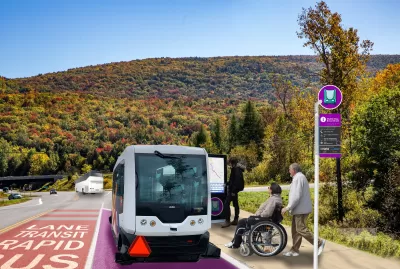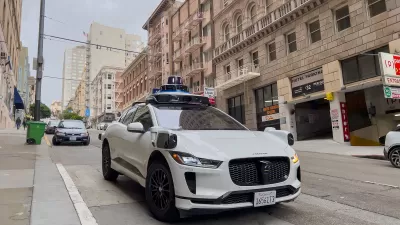The public and private sector need to partner to facilitate adoption of policy frameworks to realize the AV promise nationally.

Testing of automated vehicles (AVs) has accelerated across the United States and has created a sense of urgency to create national standards—promoting safety, innovation, and public confidence—to match the pace of technological advancement.
With a regulatory structure built entirely around human operation of vehicles—from driver’s education to traffic violation laws (including driving while intoxicated)—it’s hard to take humans out of the driving equation. In fact, the central role of human drivers can’t, and shouldn’t, change overnight. But safe and effective deployment of AVs will require a modernized framework.
Creative, evidence-based policymaking offers a preemptive way to develop use cases for AVs. With the term “use cases,” we mean those ways that AVs can fill transportation gaps and enhance the current system. Identifying these use cases and helping manage evolving risks and new regulatory considerations can by enabled by testing partnerships between public and private entities.
In the absence of federal standards, states are trying to solve the knotty policy and regulatory challenges of taking humans out of the driver’s seat. Because we know self-driving technology will keep evolving, any policy framework should set reasonable performance expectations for technology while building in the flexibility to adapt to innovation. But the policy can’t be so flexible that it amounts to no framework at all.
The promotion of a national testing strategy also helps AVs deliver maximum anticipated social benefits, like mobility for the disabled, for aging residents, and for underserved areas limited by economic and geographic constraints.

The Stantec GenerationAV team recently helped the state of Vermont finalize a framework for AV testing and accompanying guidelines, a project that excited us for several reasons. Vermont does not have perfect roads—the state counts 7,151 miles of paved roads, 6,008 miles of gravel roads, and 1,590 miles of graded earth roads. Vermont has challenging weather, with between 5 and 10 feet of snowfall per year interspersed with freezing rain. Vermont has aging and rural populations—27% of the total population is over 60 years old and 65% of the population lives in rural communities. And, yes, Vermont even has a mud season. Taken together, these challenging conditions make Vermont a place where testing should take place to ensure that AVs can operate successfully and reliably.
In developing Vermont’s framework, a snapshot of issues emerged, which many states and communities are confronting:
- Who can regulate safety? More candidly, who verifies the claims that AV testing on public roads qualifies under Federal Motor Vehicles Safety Standards? How do existing roles for licensing and registration (think human driving tests) reconcile with federal jurisdiction over vehicle safety that will be controlled by onboard computer systems is yet to be determined. (Note: In late 2020, the National Highway Traffic Safety Administration announced that it would begin developing a framework to govern automated-driving-system safety.)
- How to modernize insurance and liability partnership models? Wider testing of self-driving vehicles gives greater urgency to the task of devising new liability-and-risk-mitigation models designed to share risk. A partnership to promote an evolving technology like AVs requires an investment of time and resources from both private and public sides, and it provides an opportunity for new insurance models that share risk proportionately to encourage more testing.
- What is the right level of data reporting? Public agencies rightfully want access to data about the operation of AVs on public roads, but the private sector expresses strong concern about privacy, data security, and trade secrets. New policies should promote alignment around goals and expectations at the outset while also accounting for open-records laws. (Stantec recently helped the Transportation Research Board produce a white paper on this topic.)
- What is the right amount of interaction with law enforcement and local coordination? While local coordination can look like a barrier to testing and deploying AVs, it can also be viewed as an opportunity to educate, build trust, and promote adoption of AVs. Local coordination also can make sure the integration of AVs aligns with transportation planning documents and identify use cases that may center around tourism opportunities.
By addressing such complicated questions in our work with the Vermont Agency of Transportation, the following approaches emerge for consideration to support a national testing and deployment strategy for AVs:
- Take a mode-neutral approach. AVs won’t just carry passengers, they’ll deliver goods and services, a fact that the COVID-19 pandemic has brought into sharp focus. Policy frameworks, including access to right-of-way, fee structures, and safety considerations, will need to distinguish between passenger and goods delivery (which may never have humans in a vehicle and may be smaller and lighter from a safety regulatory perspective).
- Set standards that balance safety and innovation while technology evolves and more use cases for AVs are identified. Can we, for example, expand existing standards built around human drivers to accommodate AVs? Or should we build a new regulatory structure from scratch to cover a range of next-generation mobility solutions already being developed and tested?
- Use the need for AV policy to tackle larger issues—like the long-discussed need to rebuild infrastructure. Next-generation mobility solutions like self-driving vehicles present an opportunity to break down silos and tackle this crucial issue. Investment in a broad approach to planning, redesigning, and inspiring people-focused infrastructure can maximize the anticipated social benefits of AVs. It can also spur investment in a transportation network that gains resilience from a broader set of more balanced choices.
- Promote secure and responsible data sharing. We’ll need frameworks that align goals and expectations, ensure privacy and data security, and use anonymized data to plan, inform decision-makers, and ensure public education to support investment in the future of mobility. This starts with setting up a task force to promote discussions around goals and proposed uses of data, while making sure data collection incorporates best practices.
Without smarter and more adaptable policy and regulatory structures, we could easily lose some of the social benefits of AVs. This fluid (yet foundation-setting) moment calls for collaboration across all sectors to maximize this opportunity to improve mobility for both passengers and goods. Through a national testing strategy that promotes public and private partnerships, we can encourage investment and strengthen confidence in this emerging technology.
 Greg Rodriguez is Mobility Policy Principal with Stantec Smart Mobility and Stantec GenerationAV™. He provides regulatory and policy guidance to clients as they develop the policies and operational frameworks that support innovative transportation technologies.
Greg Rodriguez is Mobility Policy Principal with Stantec Smart Mobility and Stantec GenerationAV™. He provides regulatory and policy guidance to clients as they develop the policies and operational frameworks that support innovative transportation technologies.

Alabama: Trump Terminates Settlements for Black Communities Harmed By Raw Sewage
Trump deemed the landmark civil rights agreement “illegal DEI and environmental justice policy.”

Planetizen Federal Action Tracker
A weekly monitor of how Trump’s orders and actions are impacting planners and planning in America.

How Atlanta Built 7,000 Housing Units in 3 Years
The city’s comprehensive, neighborhood-focused housing strategy focuses on identifying properties and land that can be repurposed for housing and encouraging development in underserved neighborhoods.

In Both Crashes and Crime, Public Transportation is Far Safer than Driving
Contrary to popular assumptions, public transportation has far lower crash and crime rates than automobile travel. For safer communities, improve and encourage transit travel.

Report: Zoning Reforms Should Complement Nashville’s Ambitious Transit Plan
Without reform, restrictive zoning codes will limit the impact of the city’s planned transit expansion and could exclude some of the residents who depend on transit the most.

Judge Orders Release of Frozen IRA, IIJA Funding
The decision is a victory for environmental groups who charged that freezing funds for critical infrastructure and disaster response programs caused “real and irreparable harm” to communities.
Urban Design for Planners 1: Software Tools
This six-course series explores essential urban design concepts using open source software and equips planners with the tools they need to participate fully in the urban design process.
Planning for Universal Design
Learn the tools for implementing Universal Design in planning regulations.
Jessamine County Fiscal Court
Caltrans
Institute for Housing and Urban Development Studies (IHS)
City of Grandview
Harvard GSD Executive Education
Toledo-Lucas County Plan Commissions
Salt Lake City
NYU Wagner Graduate School of Public Service





























